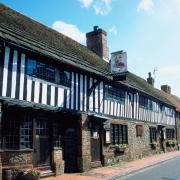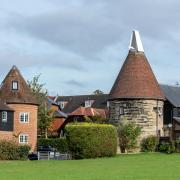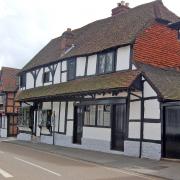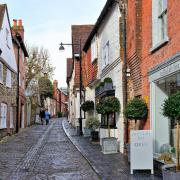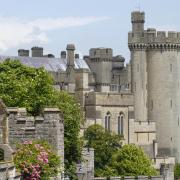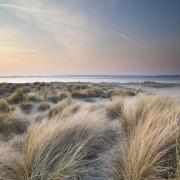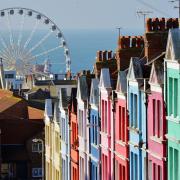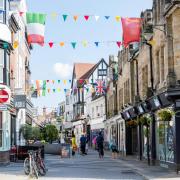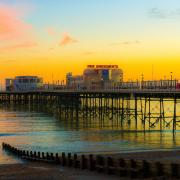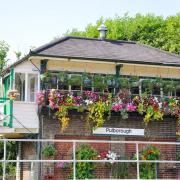The East Sussex village of Mayfield has attracted more than its fair share of famous residents. But according to legend some visitors have been less welcome than others...
For a modest village the size of Mayfield to have produced a palace and developed a close association with a saint is, in my opinion, very impressive. There is a connection between the two as plain Dunstan, as he then was, became Archbishop of Canterbury in 960, founded Mayfield Palace and established it as one of the great residences of the medieval Archbishops of Canterbury. Although it's a shame it's an ecclesiastical palace rather than a royal one and has long since disappeared, nevertheless a palace is a palace and to have had one right in the heart of your village has to be a good thing.
Before we saunter up the hill to where it was, Michael Charman, a member of the Mayfield Local History Society and my guide for the day, recounts a rather far-fetched story of Dunstan and the Devil. Before he was made Archbishop of Canterbury, Dunstan was a humble local blacksmith. One day he was working in his forge when the Devil, disguised as a beautiful woman, paid him a visit with a view to leading him astray. However, the sharp-eyed Dunstan spotted the cloven hooves beneath his visitor's dress, grabbed the Devil's nose with his burning-hot pincers and prompted his would-be wooer to leap nine miles to Tunbridge Wells to plunge his hot hooter into a cooling spring.
Michael and I wander around the grounds of what was once Mayfield Palace but is now Mayfield School. The buildings are an eclectic assortment of styles with some sufficiently ecclesiastical in appearance to evoke appropriately reverent emotions.
Although not royal, it was nevertheless visited by a number of kings including Edward I in 1299, Henry VII in the 1490s and Henry VIII together with his young wife, Katherine of Aragon, in 1510.
In 1546 Edward North bought the property and 8,000 adjoining acres for £337 6s 8p and sold it on to Sir John Gresham, a London merchant and founder of the Royal Exchange who later became Lord Mayor of London. Gresham entertained Queen Elizabeth I here and constructed a special staircase so that she could proceed privately to the courtyard below.
After Gresham's death in 1579 the former palace passed through several hands before being bought in 1617 by John Baker, one of three ironmaster brothers who were big movers and shakers in Mayfield society. Between them they owned the three grandest houses in the village. The Baker family flourished alongside the booming iron industry but struggled when it declined in the 18th century. The ex-palace was abandoned in 1740 and fell into disrepair.
Even the ruins were picturesque and proved popular with visitors to fashionable Tunbridge Wells. In 1832, the Duchess of Kent visited with Princess Victoria, who five years later was crowned Queen. The Princess enjoyed herself so much that she presented her companion, the daughter of Lord and Lady De La Warr, with her silver mounted riding whip, which is on permanent display in the school.
Evidently the place emitted a positive vibe as Mother Cornelia Connelly enjoyed a picnic here in 1863 with a small group of girls from the Holy Child School in St Leonards so much that she persuaded the Duchess of Leeds to buy the estate and present it to the Sisters of the Holy Child Jesus. Over the course of the next three years it was converted from a convent into a Roman Catholic boarding school, which is what it is today. The most significant surviving element is the 14th century hall, which is now the school chapel.
Michael and I step out onto the high street and he points to 'The Mayfield Cannon'. Probably cast during the reign of Queen Elizabeth I at Mayfield Furnace, it was restored by Mayfield Local History Society to commemorate Queen Elizabeth II's Silver Jubilee. Much larger guns were made at the furnace, which was one of Europe's major arms' producers. At the peak of the iron industry, there were no fewer than 140 furnaces in the area which helped the navy repel the Spanish Armada in 1588. One of them also manufactured Henry II's tomb.
Just a little way down the street is a remarkably attractive village sign. It owes its origins to Prince Albert, Duke of York, later to become King George VI, who in a speech in May 1920 said: "As motor travel had been increasing, it would be a welcome guide to visitors to have a revival of emblems or signs conspicuously displayed in the villages." This inspired the Daily Mail to run a village sign competition that attracted no fewer than 525 entries. Although Mayfield narrowly missed out on the £1,000 first prize, it picked up the £500 second prize and, after some discussion as to where it should go, the new sign was erected in 1922. Good old Mayfield Local History society had it cleaned, renovated and repainted in 2015 only for it to be blown down by Hurricane Katie the following year. After further repairs the now undamaged sign depicts a young woman and children in a flower-covered meadow, illustrating the Saxon origin of the village name, Maghefeld or Maid's Field.
The High Street is crammed with extraordinarily attractive period buildings of which 44 are listed. It's easy to understand why no less an authority than Coventry Patmore described Mayfield as: "The prettiest little village in Sussex."
One of the most striking buildings is Middle House. Built in the latter half of the 16th century, its name derives from the time when the Baker family owned the three biggest houses and this was the one in the middle. It remained a private residence until the late 1920s but is now an impressive pub, restaurant and hotel.
There are many glorious features within the heavily oak-beamed interior but none more so than a beautiful wooden fire surround carved by England's finest exponent of the art, Grindling Gibbons.
Possibly inspired by this magnificent piece, there once existed a Mayfield School of Wood Carving. Started in 1890, it held classes for villagers and, at its peak, employed four instructors.
I may be wrong but I can't imagine that many churches were actually founded by the saint after whom they are named. But in 960 when Archbishop of Canterbury, the former blacksmith founded the church that would later bear his name. Originally built of timber, it was replaced by a stone structure in the 12th century. In 1389 it was almost totally destroyed by fire, as was most of the village, and was rebuilt between 1410 and 1420.
Whoever said lightning doesn't strike in the same place twice was obviously unaware that St Dunstan's was struck in 1621 and again in 1905 when the spire was twisted.
Quite a few famous people have lived in and around Mayfield. Pamela L Travers moved here from London in 1934 and penned the first of her Mary Poppins books. From the world of showbiz came Richard Murdoch and Dirk Bogarde while C B Fry, who lived in Skippers Hill Manor, was one of the most remarkable sportsmen this country has ever produced. Perhaps best remembered as a cricketer who captained both Sussex and England and scored a record six consecutive centuries, he also played football for Southampton in an FA Cup Final, equalled the world-record long jump, played rugby for Blackheath and the Barbarians, and could perform a party piece that saw him leap from a stationary position on the floor backwards onto a mantelpiece, which to my mind is even more impressive than the Devil's 10-mile hop to Tunbridge Wells.
More…
- Here's what it's like to live in Steyning - This beautiful West Sussex market town is home to more than 5,500 people and an array of sports, clubs and events that make it a delightful place to live








